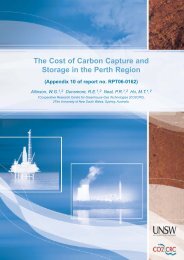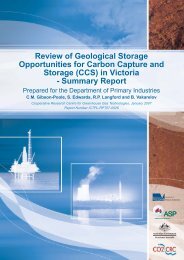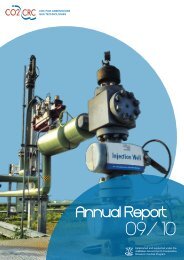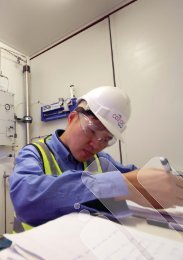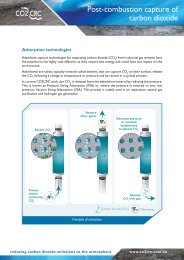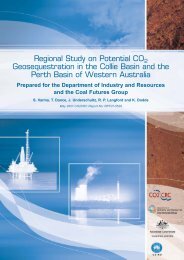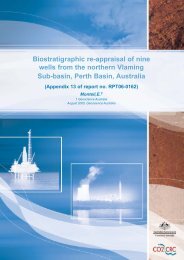Read the full report (PDF27.8 MB) - CO2CRC
Read the full report (PDF27.8 MB) - CO2CRC
Read the full report (PDF27.8 MB) - CO2CRC
You also want an ePaper? Increase the reach of your titles
YUMPU automatically turns print PDFs into web optimized ePapers that Google loves.
that a long-term mechanism exists to move water away from <strong>the</strong> potential storage area.<br />
Post–production, <strong>the</strong> hydrodynamic flow of 0.9 m/yr is focused towards a low caused by<br />
hydrocarbon production activities on <strong>the</strong> sou<strong>the</strong>rn Wunger Ridge. Hydrodynamic flows ranging<br />
from 0.2–0.9 m/yr are fairly modest when compared with <strong>the</strong> flow rate of <strong>the</strong> CO 2 front which was<br />
simulated to be migrating at an average of 174 m/y for <strong>the</strong> first 25 years (<strong>the</strong> injection phase).<br />
Multiple reservoir engineering scenarios tested injection rates for various permeability–height<br />
combinations, horizontal–vertical well combinations, as well as variations of o<strong>the</strong>r geological<br />
(i.e. heterogeneity) and engineering parameters (i.e. injection pressure and well spacing parameters).<br />
Reservoir volumetric estimates are currently uncertain and are not included in this <strong>report</strong>. Future<br />
volumetric estimates will be based on both static 3D geological and dynamic models.<br />
The preliminary dynamic modelling of a 30 x 10 km area suggests that storage space for a scenario<br />
involving <strong>the</strong> expected 25 year life-span of a small 200 Megawatt (MW) power station would be<br />
available. Such a scenario would involve injection rates at approximately 1.2 Mt per year for a<br />
total volume of approximately 30 Mt.<br />
Simulation runs using simple models, based on a coarse-scale grid, suggest that ei<strong>the</strong>r one<br />
horizontal or two vertical wells are required to inject at <strong>the</strong> proposed rate. Geological heterogeneity<br />
increases injection pressure around <strong>the</strong> wellbore and reduces injection rates compared to<br />
homogeneous models, resulting in <strong>the</strong> need for more injection wells.<br />
This study has ascertained CO 2 storage potential on <strong>the</strong> Wunger Ridge flank based on reservoir<br />
simulation of coarse-scale models. A second phase of work would be required to encompass fur<strong>the</strong>r<br />
complexities of <strong>the</strong> geology and ascertain <strong>the</strong> extent of <strong>the</strong> impact of petroleum exploration<br />
activities on <strong>the</strong> project. Large-scale storage potential may exist in low permeability rocks in areas<br />
away from well control. Small-scale storage potential will exist when fields of <strong>the</strong> Denison Trough,<br />
Roma Shelf and Wunger Ridge become depleted. The Moonie field could also become available for<br />
storage subject to operator consent.<br />
2


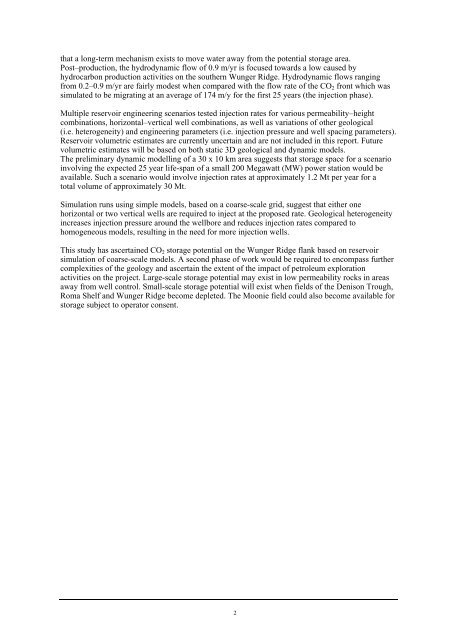
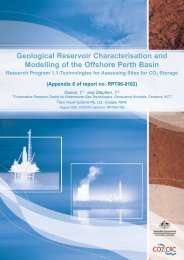
![Post-combustion solvent absorption [PDF 438KB] - CO2CRC](https://img.yumpu.com/48575763/1/184x260/post-combustion-solvent-absorption-pdf-438kb-co2crc.jpg?quality=85)

